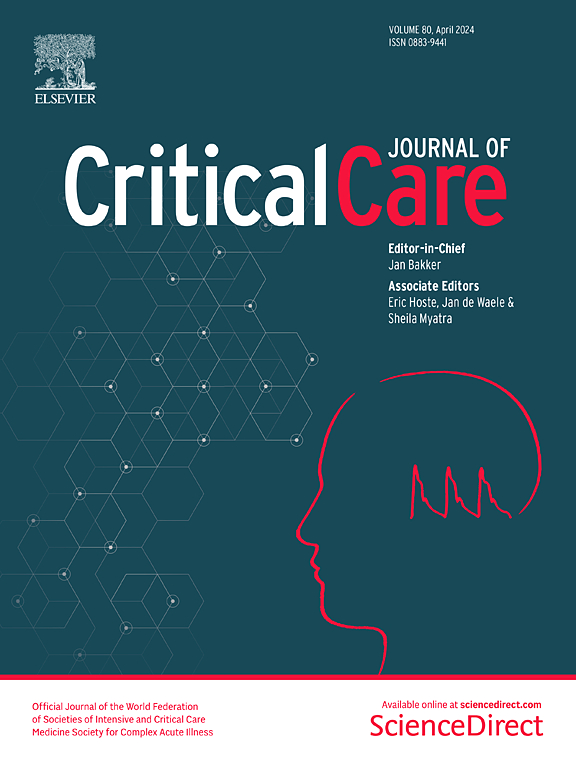The Landscape of lower respiratory tract herpesviruses in severe pneumonia patients: a multicenter, retrospective study with prospective validation
IF 8.8
1区 医学
Q1 CRITICAL CARE MEDICINE
引用次数: 0
Abstract
Herpesviruses are widely distributed in the lower respiratory tract, yet no study has comprehensively characterized their clinical features and prognostic impact in severe pneumonia. In this multicenter, retrospective study, we included severe pneumonia patients who underwent bronchoalveolar lavage fluid (BALF) metagenomic testing in intensive care units across 17 medical centers from January 2019 to June 2023. Based on metagenomic results, patients were categorized into herpesvirus-negative, HSV-1, EBV, CMV, HHV-6B, and HHV-7 groups. Propensity score matching and multivariable Cox regression were used to compare mortality between herpesvirus-positive and -negative patients. Interaction analyses were conducted to assess the impact of co-detection of different herpesviruses. Besides, main findings were validated using data from a prospective multicenter cohort. Among 1,737 enrolled patients, the 28-day mortality rate was 41.3% (718/1,737). Herpesviruses were detected in 828 patients. Detection frequencies were: HSV-1 (26.8%), CMV (17.8%), EBV (16.6%), HHV-7 (5.3%), HHV-6B (2.2%), and VZV (0.5%). Clinical characteristics varied across herpesvirus groups. No single herpesvirus was independently associated with increased mortality compared to the negative group. However, co-detection of HSV-1 and CMV was significantly associated with higher 28-day mortality (vs. both negative: adj-HR = 1.439, 95% CI: 1.093–1.894, P = 0.009). This finding was validated in a prospective cohort (adj-HR = 1.656, 95% CI: 1.061–2.585, P = 0.026). Herpesviruses are frequently detected in the lower respiratory tract of patients with severe pneumonia, with distinct clinical features across virus types. Co-detection of HSV-1 and CMV was associated with increased 28-day mortality.重症肺炎患者下呼吸道疱疹病毒的情况:一项前瞻性验证的多中心回顾性研究
疱疹病毒广泛分布于下呼吸道,但尚未有研究全面描述其在重症肺炎中的临床特征和预后影响。在这项多中心回顾性研究中,我们纳入了2019年1月至2023年6月期间在17个医疗中心重症监护病房接受支气管肺泡灌洗液(BALF)宏基因组检测的重症肺炎患者。根据宏基因组学结果,将患者分为疱疹病毒阴性、HSV-1、EBV、CMV、HHV-6B和HHV-7组。采用倾向评分匹配和多变量Cox回归比较疱疹病毒阳性和阴性患者的死亡率。进行相互作用分析以评估共同检测不同疱疹病毒的影响。此外,主要研究结果采用前瞻性多中心队列数据进行验证。在1737例入组患者中,28天死亡率为41.3%(718/ 1737)。828例患者检出疱疹病毒。检出率分别为:HSV-1(26.8%)、CMV(17.8%)、EBV(16.6%)、HHV-7(5.3%)、HHV-6B(2.2%)、VZV(0.5%)。不同疱疹病毒组的临床特征不同。与阴性组相比,没有单一疱疹病毒与死亡率增加独立相关。然而,同时检测HSV-1和CMV与较高的28天死亡率显著相关(两者均为阴性:j- hr = 1.439, 95% CI: 1.093-1.894, P = 0.009)。这一发现在一个前瞻性队列中得到了验证(j- hr = 1.656, 95% CI: 1.061-2.585, P = 0.026)。疱疹病毒经常在重症肺炎患者的下呼吸道检测到,不同病毒类型具有不同的临床特征。合并检测HSV-1和巨细胞病毒与28天死亡率增加相关。
本文章由计算机程序翻译,如有差异,请以英文原文为准。
求助全文
约1分钟内获得全文
求助全文
来源期刊

Critical Care
医学-危重病医学
CiteScore
20.60
自引率
3.30%
发文量
348
审稿时长
1.5 months
期刊介绍:
Critical Care is an esteemed international medical journal that undergoes a rigorous peer-review process to maintain its high quality standards. Its primary objective is to enhance the healthcare services offered to critically ill patients. To achieve this, the journal focuses on gathering, exchanging, disseminating, and endorsing evidence-based information that is highly relevant to intensivists. By doing so, Critical Care seeks to provide a thorough and inclusive examination of the intensive care field.
 求助内容:
求助内容: 应助结果提醒方式:
应助结果提醒方式:


